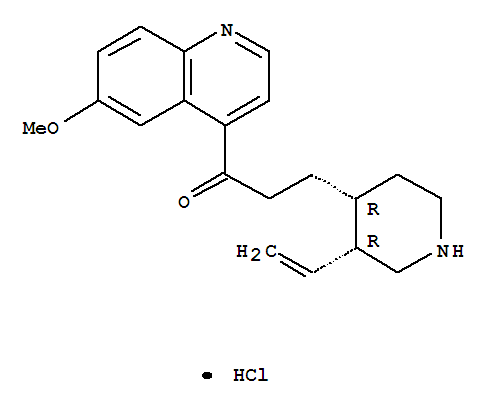- Chemical Name:Viquidil hydrochloride
- CAS No.:52211-63-9
- Molecular Formula:C20H24 N2 O2 . Cl H
- Molecular Weight:360.8777
- Hs Code.:
- European Community (EC) Number:257-739-9
- UNII:U6FXT2V136
- DSSTox Substance ID:DTXSID30966589
- Wikidata:Q27290747
- Mol file:52211-63-9.mol
Synonyms:Viquidil hydrochloride;Quinotoxine hydrochloride;52211-63-9;Quinicine hydrochloride;Viquidil HCl;Viquidil (hydrochloride);EINECS 257-739-9;UNII-U6FXT2V136;(3R-cis)-1-(6-Methoxy-4-quinolyl)-3-(3-vinyl-4-piperidyl)propan-1-one monohydrochloride;U6FXT2V136;(3R-cis)-3-(3-Ethenyl-4-piperidinyl)-1-(6-methoxy-4-quinolinyl)-1-propanone hydrochloride;3-[(3R,4R)-3-ethenylpiperidin-4-yl]-1-(6-methoxyquinolin-4-yl)propan-1-one;hydrochloride;1-Propanone, 3-(3-ethenyl-4-piperidinyl)-1-(6-methoxy-4-quinolinyl)-, monohydrochloride, (3R-cis)-;Chinotoxin;Permiran;SCHEMBL2257768;DTXSID30966589;VIQUIDIL HYDROCHLORIDE [MI];HY-105559A;VIQUIDIL HYDROCHLORIDE [WHO-DD];MS-25714;LS-122983;CS-0109500;Q27290747;1-(6-Methoxyquinolin-4-yl)-3-((3R,4R)-3-vinylpiperidin-4-yl)propan-1-one hydrochloride;1-PROPANONE, 3-((3R,4R)-3-ETHENYL-4-PIPERIDINYL)-1-(6-METHOXY-4-QUINOLINYL)-, MONOHYDROCHLORIDE;1-Propanone, 3-(3-ethenyl-4-piperidinyl)-1-(6-methoxy-4-quinolinyl)-, monohydrochloride,(3R-cis)-;3-(3-Ethenylpiperidin-4-yl)-1-(6-methoxyquinolin-4-yl)propan-1-one--hydrogen chloride (1/1)



